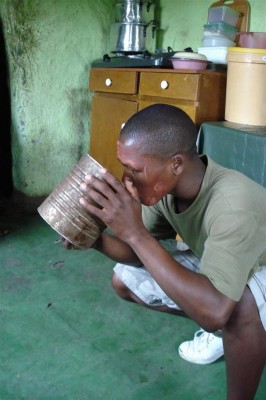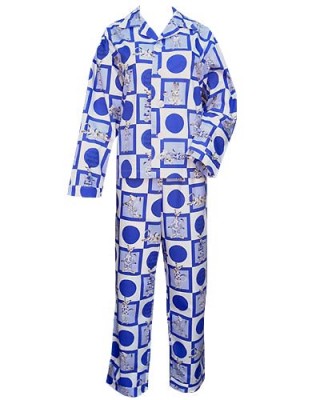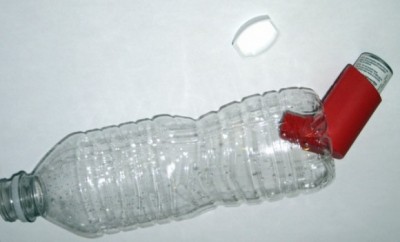I left a little earlier today so that I could skip the traffic. This was successful to some extent, saving me about 15 minutes. Unfortunately, failing to get a swipecard yesterday meant I spent around 15 minutes waiting outside until someone let me in. Eventually though, I managed to get a cup of coffee before the first session began…
Mental Health
 Maureen Wilkinson (who spoke yesterday) started us with another picture: “I’d like you to come with me to the edge of the Sahara. You are visiting an old lady, in a cut, nearing the point of death. On the vast horizon, a dust cloud appears, and it become clear that its a group of Arabs on horses. The riders are wearing bright blue robes. The constrast in vitality between their life and the dying lady is vast. Africa is a land of many contrasts.
Maureen Wilkinson (who spoke yesterday) started us with another picture: “I’d like you to come with me to the edge of the Sahara. You are visiting an old lady, in a cut, nearing the point of death. On the vast horizon, a dust cloud appears, and it become clear that its a group of Arabs on horses. The riders are wearing bright blue robes. The constrast in vitality between their life and the dying lady is vast. Africa is a land of many contrasts.
A few hundred miles away, there is a hospital. A shiny clean new building, with new wards. It is a pleasant place to be. However, a few hundred metres away there is a shack with blacked out windows. Patients are chained to the wall and fed once a day. This is the Mental Health Unit. Africa is a land of contrasts, and few none are as stark as those between the physically and mentally ill“.
Is there any other group in history that have been so set apart, forced to live in exclusion, ostracised? Lepers. And how did Jesus deal with lepers? He touched them. We need to touch those with mental health disorders. Looking at which disorders cause lost years of life due to disability, psychiatric illness leads the pack more than threefold over the next area. It causes 15% of the global burden of disease, but gets less than 1% of health spending worldwide.
On first visiting Mission Hospitals in the 70s, Maureen would ask “How do you treat those with mental illness”. They often replied “We don’t”.
Worldwide challenges include: disruption to community, absence of social welfare net, adverse social dynamics; gender inequality, women & children vulnerability. Traditional practices can cause a problem: some hospitals have established referral pathways from traditional healers – you can’t stop people using them, but if they don’t have success, encourage them to send people to the hospital. This was tried in Malawi, which led to children with burns due to epileptic fits coming into hospitals for the first time, and numbers of burns falling… 
Drugs and alcohol are a major problem in the developing world, especially Africa. Causes chronic ill health, risk taking behaviour, spousal abuse, RTAs. Community solutions and local awareness and leadership engagement can impact this.
One great story is where a group in Uganda got together with the hospital, local leaders, government and churches, and held a large community meeting. Different people stood up, asking people to stop using cannabis, influential leaders and community members each trying to engage with the youth. Finally, the local government minister stood up and said “You must all stop using it, I believe very strongly in this!”. However, someone at the back of the crowd shouted “You! You grow this evil weed, and I know where your field is!”
Catatonic schizophrenia is much more common in developing countries, and is rarely treated in the way it needs to be – thought to be evil spirits or “madness”. Commonly seen with waxy flexability and auto-obedience. Older drugs calm down patients, but it is the newer drugs which are really effective at treating the disease. Depot preparations are often more easily usable in a developing world context. Chlorpromazine, Haloperidol and Fluphenazine are common and cheap options.
There are high levels of post-natal depression, especially if a girl is born, since cultural expectations are often for male babies. Mother-in-laws are a worldwide problem!
Depression often present with somatization. There is poor cultural awareness of mental health disorders – some languages do not even have words for depression. It can present with total body pain, crawling over body, or other non-specific symptoms. In some countries, sadness is thought to be caused in the heart, and so presents with palpitations and abdominal pain. Once you get behind the story, you can often find common biological and cognitive symptoms of depression, that the patient might not have been aware of. Amitriptyline and Fluoxetine are good drugs to use: advise asking pharmacy if they can stock SSRIs, since they are cheap now, and safer in overdose. Remember to ask for risk of self harm/suicide, and be aware of increased risk at start of treatment as energy levels rise, but mood stays low.
Always think in consultations:
- Is this person physically ill?
- Are they under influence of drugs or alcohol?
- Then… could they have mental illness?
General Medicine
 Our second morning session was a joint effort from Malcolm Molyneux & John Day. We were given case studies to read and then discuss points about medicine in resource-limited settings.
Our second morning session was a joint effort from Malcolm Molyneux & John Day. We were given case studies to read and then discuss points about medicine in resource-limited settings.
The fundamentals of clinical practice and disease are the same everywhere. Pneumonia, Hypertension, Diabetes, Gastroenteritis and many other conditions remain common. Whilst there are changes – less IHD, more HIV/AIDS, increased endemic infection, etc – the underlying science of treatment and diagnosis remains static.
Expectations of patients remain unpredictable. The man who’s life we saved, but then complained that we had lost his pajama bottoms is an example of this.
It’s important to find locally who can advise and teach you, and also nationally: maybe try to make it to a grand round one a month? Try to run a regular weekly teaching session, or join an online group. We did a straw poll amongst us: In a group of 35 doctors with an interest in developing world medicine, only two won’t have access to internet. It’s becoming a highly accessible tool worldwide. Key observations:
- Fundamentals of good clinical practice are the same everywhere.
- But there are important differences in practice.
- Acquire local recommendations / guidelines.
- Learn who can help.
- Devise ways to confer regularly with staff and colleagues.
- Maximise and appreciate what you CAN do, rather than bemoan what you can’t.
- Promote other cadres to do things well.
- Note first impressions of what’s good/bad.
- Re-visit your recorded first-impressions a few months later.
- Write: record events, ideas, progress: for publication, for your own records.
Case studies:
36 year old male in rural India. Severe breathlessness since this morning, no cough/haemoptysis. Has had increasing abdominal swelling over past 3 weeks. No vomiting. EXAM: very dyspnoeic. Chest and heart normal, Abdo: ascites ++, ?hepatic mass. No peripheral oedema.
- TB Pericarditis – Common cause of ascites and hepatomegaly after R heart failure. Feel for pulsus paradoxis. Could be an acute presentation, even though usually chronic.
- ?Hep B malignancy – Most cases of Hep B are caused due to transmission in infancy. Commonly leads to hepatocellular carcinoma.
40 year old mother of 6. Vomitedx3 this morning, and had one loose stool. Then began coughing and seemed breathless. 2 hours ago had a seizure, and has been restless but not responsive since then. EXAM: GCS 8/15. Making restless, purposeless movement of all limbs. BP 110/70, pulse regular 60/min, T 36C. Breathing noisily – ?secretions ++. Chest: widespread crackles.
- Ingested toxin: organophosphates. Small pupils, floppy patient. Fasciculations. Treat with atropine.
- ?Ingested toxin: chloroquine.
- ?Hypo/hyperglycaemia.
49 year old policeman been more drowsy over last 24 hours. Now talking, but not sensibly, and can’t walk since this morning. He has complained frequently of headache during the past 2 weeks. EXAM: GCS 7/15. BP 140/100, pulse 56. T 53.3C. R pupil larger than left. R pupil does not constrict to light shone into either pupil. L pupil constricts to light shone into either pupil. Makes some movements of all limbs – seems to move right limbs more than left.
- Cerebral TB.
- ?HIV Cryptococcal/Toxoplasmosis.
- ?Sub-dural haematoma.
General Medicine Part 2
I used the lunch break to run home and pick up my wife, who was being driven slightly mentally unwell by her entrapment in a home with a child and 3 dogs. After gulping down some creamed spinach, we started again, with a brief talk from myself about Social Media and the #cmfdevhealth hashtag, before moving on to Part 2 with Malcolm & John again.
More case studies:
66 year old former athlete complains of a couple of months of tiredness and weakness, poor appetite and some nausea. A dry cough and slight breathlessness, taking laxatives for constipation and variable left-sided chest pain. EXAM: Alert, Mucosae very pale. Mild oedema of ankles, and face looks puffy. BP 170/115, P52, R24, T34.6C
- Renal Stones – stream positional? Common in developing countries, ideally needs ultrasound.
- ?Shistosomiasis.
 18 year old with episodes of wheezy breathlessness since aged 11. Well between episodes. This year, episodes lasting a few days have recurred 1-3x per month. Has been attending the clinic and is on Ventolin by inhaler. Despite this, has got much worse this week and now can’t go to work. EXAM: R32/min with audible wheeze, BP 105/70, P110 reg, T36. Chest: widespread wheezes only.
18 year old with episodes of wheezy breathlessness since aged 11. Well between episodes. This year, episodes lasting a few days have recurred 1-3x per month. Has been attending the clinic and is on Ventolin by inhaler. Despite this, has got much worse this week and now can’t go to work. EXAM: R32/min with audible wheeze, BP 105/70, P110 reg, T36. Chest: widespread wheezes only.
- Asthma. Hugely common in third world. Poor inhaler useage. Could be living in a smoky home, workplace. Poor washing of mites. Pets, etc. Try homemade spacer with plastic bottle. Try an extra steroid inhaler. If not available, use steroid inhalers. Oral ventolin
- ?Cardiac asthma, retained fluid during period with congenital heart defect.
- ?Current episode worsened by TB.
A 42 year old woman with polyuria. She has been feeling icnreasingly thirsty recently, and drinks a lot. Thinks she has lost weight. EXAM: Alert. ??slightly dry. BMI 36. BP 150/95, P72, R18, T36.1. Normal physical examination.
- Diabetes Mellitus – check a BM. Try metformin. Treat BP.
- ?Diabetes Insipidis – any history of post partum haemorrhage, which could have infarcted the posterior pituitary?
A 19 year old woman from Yorkshire is working in Uganda and has been having joint pains. Feeling feverish for 3 days, with nausea and loss of appetite. Symmetrical pain and stiffness in wrists, arms and hands. Today has noted general itchiness, especially of palms o hands. EXAM: T38C, BP 110/68, R14, P84. No visible skin lesions. Can’t make a fist easily – slight swelling of joints in both hands. Exam otherwise NAD.
- Hepatitis B.
- ?Shistosomiasis. Katayama fever – takes 3-6 weeks after exposure. Check raised eosinophilia.
- ?Reactive arthropathy to a streptococcal infection.
26 year old fisherman sent to you with progressive weakness in both legs – last 2 weeks. Also numbness in feet. UNable to pass urine, catheter inserted as bladder distended. EXAM: T36, P72, BP140/90, R23. Unable to walk, no movement in legs, with reflexes+++, Clonus++ in legs. Arms normal.
- Endarteritis Obliterans caused by syphilis. Ridiculous.
- ?Infarction secondary to sickle cell, vasculitis (HIV).
- ?Shistosomiasis.
- ?Testicular tumour metastasing.
- ?Cord compression.
- ?Pott disease – TB discitis – Hunchback of Notre Dame had this.
Ophthalmology
 David Yorston gave us our final talk of the day. As ever, I was nearly asleep by this point, despite many excellent cups of tea, but bleary eyed (get it?) I turned my attention to the exciting developing world of optic disease.
David Yorston gave us our final talk of the day. As ever, I was nearly asleep by this point, despite many excellent cups of tea, but bleary eyed (get it?) I turned my attention to the exciting developing world of optic disease.
There are two main causes of visual impairment worldwide: Cataracts and Refractive error. This is good, since both of these are resolvable with surgery and glasses, respectively. There are many causes of blindness, some of which are harder to resolve, but Trachoma, Onchocerciasis and Childhood blindness are key areas of attack by the WHO’s Vision 2020 campaign. In great part thanks to Vision 2020, the worldwide picture (get it?) for eye health is improving.
In an Ophthalmology history, you will see (get it?) a few key problems:
- My eye hurts – Acute Red Eye, Trauma
- I can’t see – Gradual loss of vision, Sudden loss of vision.
- I can’t read – Presbyopia.
Acute Red Eye:
David talked about some key red eye conditions. One that stayed with me was Supporative Keratitis, which has a very scary pus line in the anterior chamber (see picture on right), and is the treated by intensive hourly topical antibiotics – no point in giving systemic, has to be given onto the eye.
Acute iritis is almost always idiopathic. Meaning the doctor is an idiot, and the explanation is pathetic.
Trachoma is an eye infection from Chlamydia trachomatis. It used to be a minor cause of blindness in the UK, but was eradicated when we started to wash our faces. You treat it with oral azythromycin. In many developing countries, trials of prophylactic ABx to children are used if prevalence is above 10%. The key is to encourage people to maintain basic facial hygeine.
Ophthalmology neonatorum is the eye infection caused by a mother having gonnococcus, causing pus in the eyes in newborn children. Needs urgent topical antiobitics, otherwise it can cause blindness.
Corneal ulcer – stain all red eyes with fluoroscene – commonly caused by trauma, but the scary causes are generally infection, which will need treatment with antibiotics.
Cannot See:
Blindness is a major cause of morbidity, impacting wealth, health and social circumstances. There is real evidence that Cataract surgery cures poverty. Below are some key preventable/treatable problems.
- Refractive error – Corrected by pinhole.
- Cataract – Helped by pinhole, cloudy pupil, reduced red reflex.
- Glaucoma – Not helped by pinhole, sluggish pupil.
- Corneal scar – Visible corneal opacity.
- Diabetes – Diabetic retinal changes, neovascularisation, flame haemorrhages.
A Final Thought:
“He will do even greater things than these, because I am going to the Father.”
John 14:12
This verse has always been a big inspiration to David. Jesus healed many blind people in the gospels, but there are only a handful of documented cases. Through CBM, they are doing nearly half a million cataract operations a year: following in His steps we really are starting to do greater things…


Check out @bigonroad’s second day review of the #CMFDevHealth course on his blog: http://t.co/CXTOBDeo